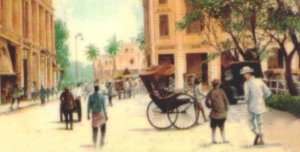
Yap Ah Loy

Yap Ah Loy was also known as Yap Tet Loy and Yap Mao Lan who was largely responsible for the development of Kuala Lumpur as a commercial and mining centre in the middle of the 1800’s. Yap Ah Loy rose from an unknown immigrant to become a Kapitan Cina and the headman of a settlement of several hundred Chinese inhabitants. The city that he had largely developed retained its pre-eminent position and became the capital of Malaysia. Today there is a street name after him known as Jalan Yap Ah Loy in the heart of Chinatown in Kuala Lumpur.
Yap Ah Loy was born in the Guangdong Province of southern China on the 14th March 1837. His parents live in the village of Tam Shui in the Kwai Yap district of the Fui Chiu prefecture. He was therefore by descent a Hakka of the Fui Chiu clan. Yap Ah Loy left China via Macao for Malaya in 1854 and found that the place is very much different from China. The scenery with tall coconut and betel palms and the small atap houses was new and fascinating to him.
On his arrival at Malacca Yap Ah Loy was given shelter by one of his clansman called Yap Ket Si. He was then taken to a tin mine in Durian Tunggal, where he stayed for 4 months. At the end of that period he left for Kesang where he found work in a shop of a relative named Yap Ng. He remainded there for a year before arrangement was made to send him back to China via Singapore. Misfortune befell him when he lost all his money while waiting for the junk to set sail in Singapore for China. Instead of going back to Malacca he and another of his relative name Yap Fook travel on foot to Lukut in Selangor
Yap Ah Loy arrived in Lukut in the state of Selangor in 1856 at the age of 19. He spent his early years in the peninsula as a miner and petty trader, but in 1862 his fortunes improved when his friend Liu Ngim Kong became Kapitan China of Kuala Lumpur, a position not only of leadership within the Chinese community but also of liaison with the Malay political system and, after British intervention in 1874, with British officials as well. He served as Liu's trusted lieutenant and became the third Kapitan China of Kuala Lumpur after Liu's death in 1869, upon which he began to put together a sound administration and a strong fighting force.

When civil war broke out in Selangor in 1870, Yap Ah Loy was faced with internecine fighting among dissident Chinese groups as well as attacks from Malay factions. His decisive victory at Kuala Lumpur in 1873 proved to be the turning point of the war and left him in a strong political position. Until 1879 he was almost supreme in the interior of the state. As the acknowledged leader of the Chinese community he had been given the powers of a Malay ruling chief by the British except for the right to tax, a restriction he easily evaded. He achieved a striking post-war recovery in the mining industry and established Kuala Lumpur as the economic centre of the peninsula. Through his control of the tin market, his ownership of local "farms" (monopolies on the sale of items such as opium and exclusive control of activities such as gambling), and his diverse business interests, he amassed a considerable personal fortune.
When in 1879 the first British resident (government adviser) was assigned to Kuala Lumpur, the power of the Kapitan China began to be undermined. None of Yap Ah Loy's successors approached his power and independence of action.
In 1884 Yap Ah Loy began to plan a visit to China. He proposed to appoint Yap Ah Shak and Chow Yuk to manage his property in his absence. For some reason the visit was postponed. On the 1st of September 1884 occurred the last of the natural catastrophes which damaged Kuala Lumpur in Yap Ah Loy’s time. A violent storm blew down 14 houses and a wing of the newly build Police barracks. The storm also damaged the Residency house and blew down the flagstaff.

At the end of 1884 Yap Ah Loy fell sick caused by bronchitis and an abcess of the left lung. In March 1885 he seemed to be recovering but then in the early morning of 15 April 1885 he died. The doctor who viewed the corpse said that death was either due to heart failure or to the poisoning by the fumes of the charcoal brazier which stood near the dead man’s head which was believed used to prepare his medicines. The doctor mentions the exceptional brightness of his eyes.
Source: Yap Ah Loy MBRAS Reprint No 9 by S.M. Middlebrook and J.M. Gullick
|
|
For more information: Click Here


Back to Robert K.H. Leo's Historical City Of Malacca Homepage